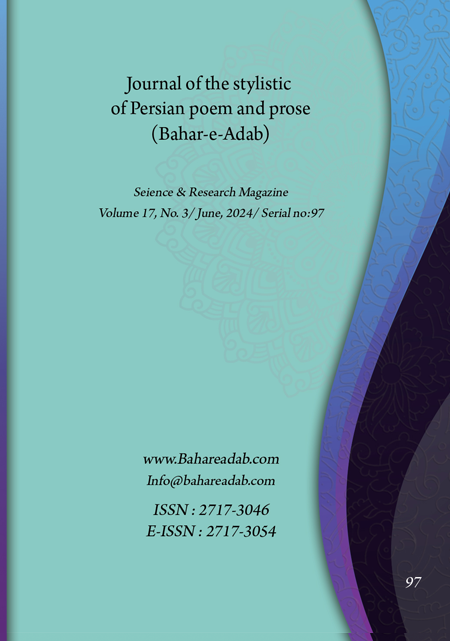- Count View : 256
- آدرس کوتاه شده مقاله: https://bahareadab.com/article_id/1646
- کد doi مقاله: Doi: 10.22034/bahareadab.2024 .17 .7266
Journal of the stylistic of Persian poem and prose
volume Number 17،
number In Volume 3،
،
issue Number 97
The analysis and interpretation of conceptual metaphor of noor in the first book of Masnavi -ye – Ma'navi based on George Lakoff and Mark Johnson theory.
Mohammadzaman Lalehzari , Shabnam Hatampour (Author in Charge), Farzaneh Sorkhi
Abstract
BACKGROUND AND OBJECTIVES: Likoff and Johnson"s research in the field of metaphor proved that the uses of metaphor are not limited to the field of literary studies. They believe that metaphor is rooted in thinking and one of its manifestations is language. Therefore, conceptual metaphor is a term in linguistics that refers to understanding an idea or a conceptual field based on another idea or conceptual field. . Based on this theory of contemporary metaphor, the functions of the metaphor of noor and image clusters related to it, i.e. vision and hearing, knowledge, noor, God, etc., were expressed and discussed in Masnavi. The purpose of this research was to find out how the conceptual metaphor of noor in the Masnavi can have a purposeful semantic correspondence with the contemporary theory of linguistics.
METHODOLOGY: Therefore, in this research, the conceptual metaphor of noor based on the theory of Likoff and Johnson in the first book of the Masnavi has been investigated with a descriptive analytical method.
FINDINGS: Rumi has used the conceptual metaphor of noor in Masnavi as a linguistic tool to expand the meanings and epistemic concepts. For this reason, the writers have analyzed the first book of the Masnavi to get the conceptual metaphor of noor along with the semantic mediators and they have found that knowledge in the first book of the Masnavi is an epistemological category and Rumi is in agreement with this conceptual idea that the universe is light. He considered pure noor as vision, hearing, noor, existence, etc., as well as a means to explain the category of annihilation and survival.
CONCLUSION: In this regard, significant results have been achieved. Several meanings have been obtained, including noor as a perfect human being, as the sun, moon, food, etc. And the general result is that the assumptions of conceptual metaphor are suitable for analyzing and explaining the abstract categories considered by Molavi Bastari.
Keyword
conceptual metaphor
, Johnson
, Likaf
, Mashnavi
, Noor.
- Chevalier, Jean, and Gerber Allen. (1387). the culture of symbols, translation sodabeh fazaeli, Tehran: jeyhoon, the fifth volume.
- Ahmadi, Ahmad, (1393). Persian literature (3), Tehran: Iran textbook publishing company.
- Lekoff, George, and Johnson, Mark. (1397), the metaphors we live with, translation hajar agha ebrahimi, Tehran: elm.
- Zamani, karim, (1390), a comprehensive description of Masnavi Manavi. Ferst book, Tehran: etelaat.
- Zamani, karim, (1388), a comprehensive description of Masnavi Manavi. Second book, Tehran: etelaat.
- Zamani, karim, (1397), a comprehensive description of Masnavi Manavi. Third book, Tehran: etelaat.
- Zamani, karim, (1400), a comprehensive description of Masnavi Manavi. Fourth and sixth book, Tehran: etelaat.
- Zamani, karim, (1398), a comprehensive description of Masnavi Manavi. Fifth book, Tehran: etelaat.
- sajadi, seyed jafar, (1389), Dictionary of mystic terms and interpretations, Tehran: ahoora.
- Suhravardi, Shahabuddin, (1355), hekmatol eshragh, translated and explained by Jafar sajadi, Tehran: Tehran University Publications.
- Shafi'i Kodkani, Mohammad Reza, (1358). Sorkhayal in Persian poetry, Tehran: agah.
- Shafi'i Kodkani, Mohammad Reza, (2016). The states and words of Abu Saeed Abul Khair, Tehran: sokhan.
- Shamisa, Siroos, (1369). Excerpts of Molavi's Ghazliat, Tehran: Foundation Publishing, Volume 2.
- Ain al-Qadaa, Abdullah bin Muhammad, (1377), the letters of Ain al-Qadat Hamdani, Tehran: Asatir, vol.1.
- Fotoohi, Mahmood, (1385), Image rhetoric, Tehran: Sokhan.
- Kezazi, Mirjalaluddin, (1368). In another way, Tehran: markaz.
- Kianinejad, Zainuddin, (1377). Manifestations of ancient Iranian mysticism, Tehran, 7th edition.
- Mohammadi Asiabadi, Ali, (1387). Hermeneutics and symbolism in Shams's sonnets, Tehran: Sokhan.
- Molavi, Jalaluddin, (1339). Koliat Shams or Diwan Kabir, with corrections and margins by Beed Al-Zaman Forozanfar, Tehran: University of Tehran Press.
- Molavi, Jalaluddin, (1369). Fieh ma fieh, corrected by Badi al-Zaman Forozanfar, Tehran: Amir Kabir.
- Maulvi, Jalaluddin, (2004). Kalyat Shams, corrected by Badi al-Zaman Forozanfar, Tehran: Amir Kabir, vol. 18.
- Maulvi, Jalaluddin, (2005). Fieh ma fieh, corrections and margins of Badi al-Zaman Forozanfar, Tehran: Negah.
- Nilipour, Reza, (2014). Metaphorical language and conceptual metaphors, Tehran: Hermes.
- Homai, Jalaluddin, (1374). Rhetoric techniques and literary industries, Tehran: Homa publishing house.
- Lakoff, G. & M.Johnson. (1980).Metaphors we live by. Chicago and London: Chicago University of Press.

